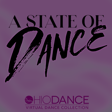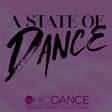
Flamenco’s Past, Present, and Future through a Latinx Lens with Griset Damas-Roche and Amy Schofield
Season Two, Episode Six: Our guests for the season finale are Griset Damas-Roche and Amy Schofield.
Born in Havana, Griset Damas Roche studied ballet at Cuba’s Instituto Superior de Arte and the Ballet of Havana. In 1998 she moved to Bogotá, Colombia, teaching flamenco and as a choreographer. In 2014, Griset moved to Columbus, with her family, where she taught for Flamenco del Corazón school. She opened UWillDance, a flamenco studio in Plain City. Griset was invited to join the city’s promotion campaign “Columbus Makes Art”. She has performed with the Columbus Symphony Orchestra, the Chautauqua Symphony Orchestra, and the Symphony Orchestra of Princeton. Griset leads the Flamenco Company of Columbus, which includes renowned and expert musicians from Ohio and Spain. Her newest project is Caña Flamenca, a trio of female flamenco dancers.
Amy Schofield (she/her/ella) holds a Master of Fine Arts in Dance from the University of New Mexico and a Bachelor of Fine Arts in Dance from the University of the Arts in Philadelphia. She has studied flamenco baile and cante at the Fundación de Arte Flamenco de Cristina Heeren in Seville and the Centro de Arte Flamenco y Danza Española Amor de Dios in Madrid, as well as numerous workshops in Spain and the US. Amy is a teaching artist with Flamenco Vivo Carlota Santana and is pursuing a PhD in Dance Studies at The Ohio State University where she researches flamenco dance in the US-American context and dance pedagogy.
OhioDance A State of Dance is a six-part series coming out the fourth Friday of each month through November 2024. This podcast is driven by the OhioDance mission to secure the foothold of dance in Ohio through increasing visibility, firming viability, and elevating the position of dance in Ohio.
In 2016, a five-person team set out on a mission to capture the achievements of persons and institutions who have shaped the intricate diversity of dance history and practice within the state of Ohio and weave them together in an easily accessible digital format. This we call the OhioDance Virtual Dance Collection. As of 2024 we have highlighted 37 individuals and institutions. The team has traveled over 5000 miles and interviewed hundreds of individuals in all five regions of Ohio. vdc.ohiodance.org
If you like what you are listening to and are not a member of OhioDance, you can go to ohiodance.org and click the membership button to join and receive the many benefits that come with your membership. You can also donate through our purple donate button.



